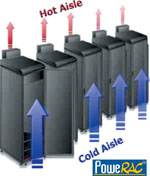
Less than 30 years ago, a single, high-end computer easily filled what is today the data centre. But such 'big iron' systems are now the exception. Most modern data centres consist of racks of servers. Over time, systems have shrunk to the point at which a rack can easily hold a dozen servers, but the need for more power in less space continues.
Blade servers are the next advancement in the ever-shrinking hardware footprint. They are technically similar to traditional tower servers but are designed for mounting in a rack. A few years ago, a rack-mounted server commonly required two or three mounting bracket units - 2U (3,5" or 8,9 cm) or 3U (5,25" or 13,3 cm) - of cabinet space. More recently, manufacturers have started introducing systems that require only 1U (1,75" or 4,5 cm) of cabinet space. Suddenly a rack that was limited to holding nine or 10 2U servers can house 20 servers.
Physical rack optimisation
Most system-, rack- and room-level cooling issues are created by insufficient airflow or the inadvertent mixing of hot and cold air. The need for sufficient airflow is obvious, but is often overlooked by IT personnel who are focused on other concerns. The mixing of hot and cold air is a more subtle issue, but equally problematic, since it can dramatically reduce the efficiency of a cooling system without impacting airflow.
* Understand airflow requirements for specific equipment: There are four basic airflow scenarios: bottom-to-top (and the basic law of physics dictates that hot air rises, so a bottom-to-top scenario should be the first consideration), top-to-bottom, front-to-back, and side-to-side. Understanding the requirements for specific equipment will enable an efficient rack-level design and cooling strategy. Map the technologies under consideration as part of the Performance Planning activities against the thermal characteristics specified by the vendor(s).
* Standardise on racks designed for high-density environments: Standardise on appropriate power and thermal policies to make effective rack decisions. Examples: Avoid shallow racks to ensure in-rack cabling will not obstruct airflow. Considering racks that support retrofit fan or cooling units (but verify the benefits of these add-on units) minimises future risks associated with miscalculations. Planning for localised supplemental cooling for individual racks can accommodate future high-density systems without compromising room-wide efficiency.
* Arrange racks in rows to establish hot and cold aisles: Racks should be aligned front-to-front along cold aisles, and back-to-back along hot aisles. Within each row, racks should be tightly abutted. For this strategy to be effective, cold air must be delivered to cold aisles and hot air extracted from hot aisles. Work to eliminate hot air mixing, which will cause short cycling of the cooling system.

* Ensure adequate airflow to individual racks and systems: Clearly define power and cooling requirements at the room, row, and cabinet level. Ensure sufficient airflow to racks based on system-level inlet air temperature and airflow requirements, and use thermal and aerodynamic analysis tools to model and design your cooling solutions. Insufficient airflow will often result in hotter systems and turbulence that decrease cooling efficiency. For example, if a rack requires more cold air than the room provides, its fans will pull a mix of hot and cold air. This will result in reheating of the room, hotter systems, unhealthy airflows, and a substantial reduction in the efficiency of the cooling system.
The PoweRac solution
Customer-driven requirements has always been the mainstay of the solutions that DataNet offers, and together, we have designed the new PoweRac. The key is to build in flexibility and expandability in the original data centre design. The PoweRac is an on-demand architecture for mission-critical physical infrastructure.

From a single enclosure to 1000 or more, DataNet has a configuration that will meet customer needs, now and for the future. PoweRac fully integrates power, cooling, and management within an enclosure-optimised design. These customisable systems are built from standard, off-the-shelf components that are modular and pre-engineered to fit together.
The key features of PoweRac include:
Availability: High cooling density available (up to 20 kW of cooling per rack); Increased runtime from minutes to hours; Redundant design eliminates single points of failure; Factory pre-tested (ISO-9001: 2000) components reduce downtime; Locking enclosures provide a secure environment.
Adaptability: Rack-based modular approach allows system to be easily moved; scalable design accommodates changing power densities; power distribution system accommodates all receptacle types; vendor-neutral enclosure guarantees compatibility with all major IT vendors.
Speed: Pre-configured systems; configure-to-order approach accelerates installation; Rack-based, standardised modules facilitate quick installation.
DataNet is a focused independent infrastructure distribution company providing leading-edge structured cabling solutions, 19" racking systems and purpose-built electronic enclosures to the network installer market.

For more information contact Datanet, +27 (0)11 990 6000.

© Technews Publishing (Pty) Ltd | All Rights Reserved